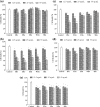Characterization and anti-tumor activity of saponin-rich fractions of South Korean sea cucumbers (Apostichopus japonicus)
- PMID: 32431354
- PMCID: PMC7230107
- DOI: 10.1007/s13197-020-04266-z
Characterization and anti-tumor activity of saponin-rich fractions of South Korean sea cucumbers (Apostichopus japonicus)
Abstract
In this study, the saponin-rich fractions of five individual (two Red and three Black) sea cucumbers (Apostichopus japonicus) in South Korea were investigated for their antiproliferative effect against HL-60, B16F10, MCF-7, and Hep3B tumor cell lines. The red sea cucumber saponin-rich fraction (SSC) from Jeju Island (JRe) decreased the growth of HL-60 with an IC50 value of 23.55 ± 3.40 μg/mL, which represented the strongest anticancer activity among the extracts. Further, SSC downregulated B-cell lymphoma extra-large (Bcl-xL), while upregulating, to different degrees, Bcl-2-associated X protein (Bax), caspase-9, caspase-3, PARP cleavage, and apoptotic bodies in cancer cells. Evidence for SSC inducing apoptosis via the mitochondria-mediated pathway was found. The contents of SSCs were determined using ultra high-performance liquid chromatography coupled with a quadrupole orbitrap mass spectrometry to comparatively evaluate the regional influence. In West Sea, the total SSC content of A. japonicus was 15.5 mg/g, representing the highest content, while A. japonicus in the South Sea yielded the lowest content at 8 mg/g. The major saponin constituent in SSC was identified as Holotoxin A1, which may the anti-tumor compound in A. japonicus.
Keywords: Anticancer activity; Apostichopus japonicus; Holotoxin A1; Saponin.
© Association of Food Scientists & Technologists (India) 2020.
Conflict of interest statement
Conflict of interestThe authors declare that they have no conflicts of interest.
Figures





Similar articles
-
Metabolomic analysis of white, green and purple morphs of sea cucumber Apostichopus japonicus during body color pigmentation process.Comp Biochem Physiol Part D Genomics Proteomics. 2021 Sep;39:100827. doi: 10.1016/j.cbd.2021.100827. Epub 2021 Apr 20. Comp Biochem Physiol Part D Genomics Proteomics. 2021. PMID: 33894529
-
Cloning and characterization of a phosphomevalonate kinase gene that is involved in saponin biosynthesis in the sea cucumber Apostichopus japonicus.Fish Shellfish Immunol. 2022 Sep;128:67-73. doi: 10.1016/j.fsi.2022.07.073. Epub 2022 Jul 31. Fish Shellfish Immunol. 2022. PMID: 35921931
-
The Cytotoxicity of Dacarbazine Potentiated by Sea Cucumber Saponin in Resistant B16F10 Melanoma Cells through Apoptosis Induction.Avicenna J Med Biotechnol. 2016 Jul-Sep;8(3):112-9. Avicenna J Med Biotechnol. 2016. PMID: 27563423 Free PMC article.
-
Chemical substances and their activities in sea cucumber Apostichopus japonicus: A review.Arch Pharm (Weinheim). 2024 Jan;357(1):e2300427. doi: 10.1002/ardp.202300427. Epub 2023 Oct 18. Arch Pharm (Weinheim). 2024. PMID: 37853667 Review.
-
Effects of dietary Vibrio sp. 33 on growth, innate immunity, gut microbiota profile and disease resistance against Vibrio splendidus of juvenile sea cucumber Apostichopus japonicus.Dev Comp Immunol. 2024 Jan;150:105081. doi: 10.1016/j.dci.2023.105081. Epub 2023 Oct 13. Dev Comp Immunol. 2024. PMID: 37839671 Review.
Cited by
-
Fucoxanthin-rich fraction from Sargassum fusiformis alleviates particulate matter-induced inflammation in vitro and in vivo.Toxicol Rep. 2021 Feb 6;8:349-358. doi: 10.1016/j.toxrep.2021.02.005. eCollection 2021. Toxicol Rep. 2021. PMID: 33665132 Free PMC article.
-
Comprehensive metabolomics of Philippine Stichopus cf. horrens reveals diverse classes of valuable small molecules for biomedical applications.PLoS One. 2023 Dec 6;18(12):e0294535. doi: 10.1371/journal.pone.0294535. eCollection 2023. PLoS One. 2023. PMID: 38055702 Free PMC article.
-
Antioxidant, Antiviral, and Anti-Inflammatory Activities of Lutein-Enriched Extract of Tetraselmis Species.Mar Drugs. 2023 Jun 21;21(7):369. doi: 10.3390/md21070369. Mar Drugs. 2023. PMID: 37504900 Free PMC article.
-
Low Molecular Weight Oligosaccharide from Panax ginseng C.A. Meyer against UV-Mediated Apoptosis and Inhibits Tyrosinase Activity In Vitro and In Vivo.Evid Based Complement Alternat Med. 2021 Feb 26;2021:8879836. doi: 10.1155/2021/8879836. eCollection 2021. Evid Based Complement Alternat Med. 2021. PMID: 33727947 Free PMC article.
-
Application of MS-Based Metabolomic Approaches in Analysis of Starfish and Sea Cucumber Bioactive Compounds.Mar Drugs. 2022 May 12;20(5):320. doi: 10.3390/md20050320. Mar Drugs. 2022. PMID: 35621972 Free PMC article. Review.
References
-
- Barry MA, Behnke CA, Eastman A. Activation of programmed cell death (apoptosis) by cisplatin, other anticancer drugs, toxins and hyperthermia. Biochem Pharmacol. 1990;40(10):2353–2362. - PubMed
-
- Baskić D, Popović S, Ristić P, Arsenijević NN. Analysis of cycloheximide-induced apoptosis in human leukocytes: fluorescence microscopy using annexin V/propidium iodide versus acridin orange/ethidium bromide. Cell Biol Int. 2006;30(11):924–932. - PubMed
LinkOut - more resources
Full Text Sources
Other Literature Sources
Research Materials
Miscellaneous
